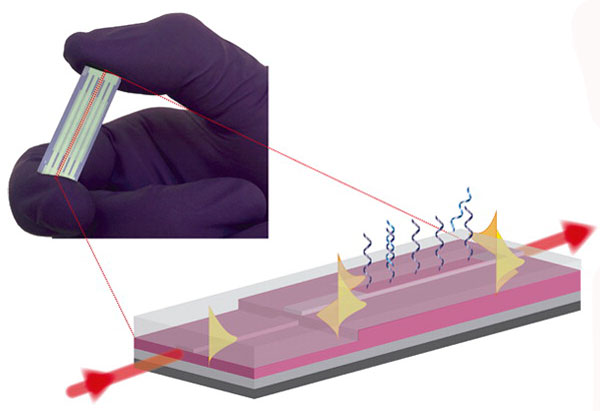Thursday, 11 August 2016
An ultrasensitive and specific diagnostic sensor based on interferometric bimodal nanowaveguides
Researchers from the ICN2 Nanobiosensors and Bioanalytical Applications Group, led by Prof Laura Lechuga, have designed a nanophotonic biosensor for ultrasensitive detection of microRNAs in complex media. Results published in ACS Sensors demonstrate that such devices can be used as an ultrasensitive and specific diagnostic tool for the prediction of diseases (such as cancer) with well-defined microRNA signatures.

Micro-RNA signatures have emerged as advantageous biomarkers for disease prediction opening the route for the development of more direct and accurate therapies. There is an urgent need for reliable tools which can offer fast, highly sensitive, and selective detection of multiple miRNAs in complex matrices as opposed to the conventional techniques.
Researchers from the ICN2 Nanobiosensors and Bioanalytical Applications Group, led by Prof Laura M. Lechuga, have designed a nanophotonic biosensor with potential multiplexing capabilities based on interferometric bimodal nanowaveguides for ultrasensitive detection of microRNAs in complex media. The results have been recently published in ACS Sensors. The biosensor was employed for the detection and quantification of miR-181a at attomolar concentrations directly, and for the first time, in human urine samples of bladder cancer patients with no need for prior sample purification or amplification steps. The authors of the work are Dr César S. Huertas, Dr David Fariña, and Prof Laura M. Lechuga.
The results demonstrate the extreme selectivity of the methodology showing the discrimination of homologous sequences at single nucleotide mismatch and its pre-miRNA. A significant overexpression of miR-181a in bladder cancer patients was appreciated when compared with healthy controls, suggesting the implication of this miRNA in bladder cancer. The results show that the biosensor based on interferometric bimodal nanowaveguides can be used as an ultrasensitive and specific diagnostic tool by the early and fast detection and quantification of microRNAs for the prediction of diseases (such as cancer) with well-defined microRNA signatures.
Article reference:
César S. Huertas, David Fariña, and Laura M. Lechuga. Direct and Label-Free Quantification of Micro-RNA-181a at Attomolar Level in Complex Media Using a Nanophotonic Biosensor. ACS Sens., 2016, 1 (6), pp 748–756. DOI: 10.1021/acssensors.6b00162
http://pubsdc3.acs.org/doi/full/10.1021/acssensors.6b00162

